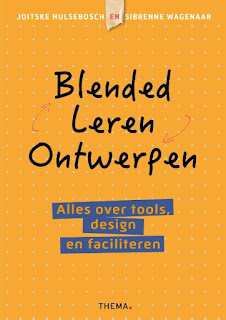Sibrenne and I are looking forward to May 20, the day that our book '
Blended learning design' (in Dutch) will be published. It was a happy writing process (18 days in all), but the proofreading was kind of tough. I read the whole book twice and had not really planned this intense kind of proofreading. But it looks wonderful! So I feel relieved that the book is currently at the printing press (ofcourse there will be an ebook too!).
The outline of the book is - organizing the start (with design approaches etc), design, innovative blends, from goal to tools, from infographic to interactive videos (on learning materials), online facilitation and online specials.
The 3P model
One of my favorite models is the 3P model by Chatti, Matthias Jarke and Marcus Specht. The model is developed in response to the changing world of online media and information. Trainers are now 'competing with Youtube' as Hans de Zwart said. Rather than competing, you should make good use of the available sources and use them for pull learning activities. In that way people learn more pro-actively plus you teach them how to network, find and judge resources. Please find my explanation of the 3P model using Squigl.
The 3P model in the water management and policy course
An example: with the 3P model we are developing a course for civil servants dealing with water management and policy, popularly known as the water course. Important principles for this course are:
- We focus on the learner, his needs and preferences.
- We provide a varied program in which we actively involve participants in the design.
- We choose a learning platform that they can continue to use after the process.
- You learn with others. We want to focus on getting to know each other, learning from each other and expanding the network.
The process takes three months. 120 participants participate and they are guided by three facilitators with knowledge of the business. The first week they get to know each other on the basis of statements. Participants are explicitly invited to share their own professional practice / experiences. (Participation) Questions are: what is your engagement with water management? Which challenges do you see? What questions do you have? We organize a live session to inventory and cluster these experiences. This clustering helps in the development of elective modules.
This is followed by two months, during which everyone takes a module of their choice. (Personalization) Each module has an assignment in which something must be selected or designed that is useful in one's own practice. The groups themselves look for information. There is a list of experts they can interview (Pull). Each group is also asked to contact at least one company. The process is concluded with a presentation of the products of the groups. The participants also discuss how this group may wish to continue as a knowledge network and who can play a facilitating role in this.
Using Squigl to make animations
I am a big fan of Squigl. Squigl works with text and you search images. There is a library of images you can use and this library is expanding, hence there is is already a wide choice. However, I still wish to draw my own images using my Wacom tablet. You can record your own voice or use an automated voice (which I did since I am not a native English speaker). Do you want to know more about how to use Squigl? Watch
this video.

